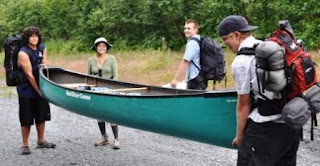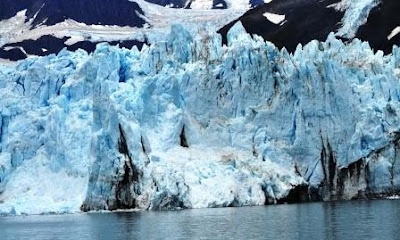 |
| Worthington Glacier near Valdez, Alaska |
And so from Mile 0 in Dawson Creek all the way to Mile 1422 in Delta Junction, we completed navigating the famed Alaska Highway in a week. We reached Alaska from northern British Columbia on our first wedding anniversary (8/8/08) and our month there will always remain etched in our memories! Let me tell you about how my dream of spending a lovely summer in Alaska came true! We will cover Tok, Valdez, Anchorage, Homer, Whittier, Denali National Park, Fairbanks, North Pole, and the little town of Chicken, Alaska, in two parts.
Tok was a waypoint. We arrived late and quickly hooked Star to electricity and water, made our dinner, watched a movie, and called it a night --- that is, after getting a call from April, my youngest, about her musings over her future. The next morning we woke up to a day completely covered with smog from the forest fires that were raging all around. Quickly, we called Cristine, Bill’s youngest who makes Anchorage her home, and told her we would postpone our seeing her for a few days and go to southern Alaska first as the smog was supposed to have enveloped the north from Anchorage to Fairbanks.
.
 |
| longest boat ramp in the world |
There were a few showers on the way to Valdez, Alaska; the air was damp and a lot of fog hovered around. As we lost cell signals and our broadband communications, I commented to Bill, ‘Gosh, the glaciers are puny around here. They are just tiny patches of white.’ But a few minutes later it changed. All of a sudden, as Star negotiated a bend, a large white mountain appeared before us. It was Worthington Glacier, the first glacier that I could walk to from the roadside! Bill climbed it (I feigned ankle pain) and brought back a piece of the blue ice rock which we quickly deposited into our freezer! I could have ended the trip right then out of sheer delight!
 |
| lots of pink salmon near Allison Park! |
Valdez is a quaint little fishing town in a beautiful setting. Low-lying clouds circled the town and the boats on the marina. The longest boat ramp in the world reached far out into the waters, which seemed to be overcrowded with pink salmon that were spawning nearby. Allison Park was a great nature camp on the water. Budding fishermen lined the banks. The hiking trails were filled with berry bushes that the bears had ravaged. Bill and I were a little bit too late! But, better the berries than us!
 |
| Alaska gas pipeline |
Up in the hills where the trails wound, we came across a section of the Alaska gas pipeline. But the more special thing we saw were three young men who, in their flip-flops, were hauling a canoe, heavy with provisions and equipment, up the steep trail to camp up in the mountains. It is definitely not about age! But what a lifestyle! If only we were a wee bit younger!
 |
| crazy, but happy, teenagers |
 |
| Matanuska Glacier |
We debated going into the Wrangell-St. Elias National Park. It would take a few more days and we wanted to go back to our planned route and see Cristine. So, we missed the chance (again!) to see the highest point of the Canadian Rockies! On the way back to Anchorage, we passed by the 27-mile long Matanuska Glacier. It was so unique because the ice had spilled down to the valleys in a long thinning winding white wave. We tried to reach it but the way there were all through private ‘for a fee’ places. We wondered why…or maybe we were just on the wrong side!
 |
| Homer beyond the hills |
Anchorage was the neat town we expected it to be. There was no hint of the cold winter that had just passed. Kyle, Bill’s first-ever grandson arrived for a vacation with his mother (her birthday gift for him; he currently stays with his father in Hilo, Hawaii) and us. After celebrating his birthday with a dinner in Anchorage, we took a trip to Homer, Alaska (the halibut fishing capital of the world) at the southwestern tip of the state. It has a famous spit jutting out into the cold blue waters of the Bering Sea.
 |
| halibut catch of the day |
There the two guys fished to their hearts’ content and we gave the fish they caught to the chef at the inn where we were staying. That night we had a seafood feast! The next day we went hunting for souvenirs and good eats at the quaint shops and restaurants in the colorful huts perched above the waters along the shore. I even had my photo taken with the largest halibut (almost 200 pounds for one) caught in a derby that day. And that second night we had a few drinks at the famous Salty Dawg Café on the spit and posted our Philippine peso 100 bill and Cristine’s US $1 on its currency-covered ceilings and walls.
 |
| a cruise ship docked in Whittier, Alaska |
But Kyle had to leave to go back to work in Hawaii (he installs solar panels). So only the three of us were able to go to the next adventure: a 4-hour Glacier Bay Cruise from Whittier, Alaska. Whittier is a small town of about 200 (which doubles during summer) on the western edge of south central Alaska (Valdez was on the southeastern part). Recently, a number of cruise lines have begun to use Whittier as a departure port for their Gulf of Alaska Cruises. Whittier is only 62 road miles southeast of Anchorage, separated from Alaska’s road system by a 2.5 mile long tunnel that is shared by alternating one-way auto and railroad traffic (quite an experience in itself).
 |
| glacier at Resurrection Bay |
 |
| glacier at College Fjords |
The cruise took us to see 26 glaciers up close, some rising to 1,700 feet above sea level. We rode in a high speed catamaran with huge picture windows inside the two enclosed decks (there are extensive outside viewing areas too). The voyage included visits to Resurrection Bay and the College Fjords. We saw several types of glaciers: Alpine (hanging), Piedmont (on mountaintops) and Tidewater (on the water edge). We did not see any glaciers calving (when broken pieces of ice fall into the water and become icebergs) but we saw sea otters, seals, porpoises, sea lions and whales. We were most surprised as we approached…Surprise Glacier, a very blue tidewater glacier many of whose pieces that had calved were floating on the icy waters around the vessel (shades of Titanic). The highlight was when the crew served us glacial blue margaritas from the ice they harvested from an iceberg!
 |
| Surprise Glacier |
Next Stops: Denali National Park, Fairbanks, North Pole, Chicken, in Alaska












































